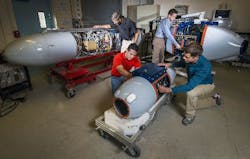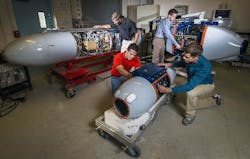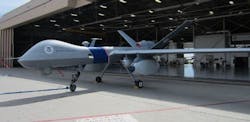Sandia, U.S. Air Force test airborne Harvester sensor payload
ALBUQUERQUE, N.M., 10 Jan. 2013. U.S. Air Force personnel, together with industry and academia, are testing the capabilities of relatively inexpensive unmanned aerial vehicles (UAVs) equipped with radiation sensors from Sandia National Laboratories engineers.
Harvester, a Sandia National Laboratories-developed airborne particulate-collection system, is designed to collect airborne radioactive particles for analysis from its perch on a remotely piloted aircraft system (RPAS). Harvester would be called upon in the event of nuclear device detonation virtually anywhere on Earth.
A team of engineers demonstrated Harvester’s capabilities at Grand Forks Air Force Base in Grand Forks, N.D., in late September. The system “tasted” the atmosphere with two particulate sampling pods during the event, according to a spokesperson. A third pod would provide directional guidance by following the trail of gamma radiation during an actual event.
The system could “fly right down the throat of telltale radiation over a broad range of altitudes [to collect much-needed radiation data] without exposing a human crew to hazards,” the spokesperson adds.
The Grand Forks demonstration is part of a formal Department of Defense (DOD) Joint Capability Technology Demonstration (JCTD) that mated the Harvester modular pods to the long wings of a Department of Homeland Security Customs and Border Protection-provided MQ-9 Reaper UAV.
The modular pods eliminate the need for costly, permanent aircraft modifications that would limit the number of aircraft platforms on which Harvester can be flown.
Officials anticipate the three sensor pods plus additional hardware, software, and ground-control equipment to be deployed on aircraft in the Air Force’s investigatory arsenal in the next few years.
“There’s a high likelihood the Air Force will make Harvester operational in 2014 to augment its current manned aircraft collection capability,” says Sandia Project Lead Joe Sanders. “For maximum responsiveness, we continually engaged with the Air Force to address its technological and operational needs throughout the project.”
The Harvester’s Directional Gamma Radiation Sensor (DGRS) helps guide the aircraft toward the radioactive plume using four large sodium-iodide radiation detectors and a complex processing algorithm. The Harvester equipment operator informs the pilot, in a remote UAV ground control station, to fly toward the plume’s “hot spot.”
Air passes through the samplers as the Reaper cruises at 200 mph, as particles stick to filter paper fibers. A separate radiation sensor analyzes the filter in real time to estimate the type and quantity of radioactive particles collected. More extensive examination of the filters occurs after the aircraft has landed.
Harvester was developed by Sandia with support from the Albuquerque office of National Technical Systems, an international engineering firm. The National Nuclear Security Administration’s Office of Nonproliferation Research and Development funded the research and development phase, while the Defense Threat Reduction Agency and the Office of the Secretary of Defense’s Acquisition, Technology, and Logistics Rapid Fielding Office funded the development and qualification phase as part of the JCTD.


